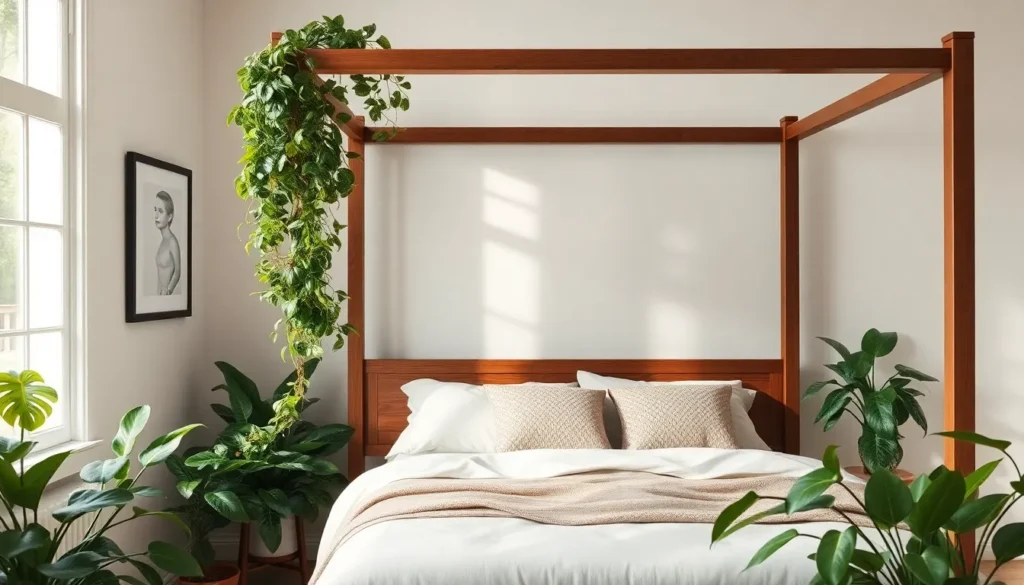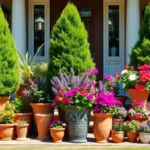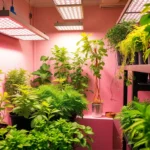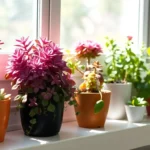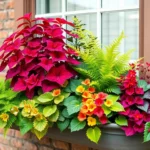We’ve all dreamed of transforming our bedrooms into serene retreats that feel like peaceful sanctuaries. A canopy bed adorned with lush plants creates exactly that magic – turning your sleeping space into a botanical paradise that promotes better rest and cleaner air.
Imagine waking up surrounded by cascading greenery and gentle morning light filtering through natural foliage. This isn’t just about aesthetics; it’s about creating a healthier sleep environment where plants work tirelessly to purify your air while you dream. The combination of a classic canopy bed structure with carefully chosen plants offers endless possibilities for customization.
Whether you’re working with a small apartment bedroom or a spacious master suite we’ll show you how to achieve this enchanting look safely and stylishly. From selecting the right plants that thrive in bedroom conditions to installing proper support systems that protect both your plants and your sleep quality – this botanical bedroom trend is more achievable than you might think.
Transform Your Bedroom Into a Botanical Paradise With a Canopy Bed With Plants
Creating a botanical paradise in your bedroom requires careful planning and strategic plant placement around your canopy bed. We’ll guide you through each essential step to achieve this stunning transformation while maintaining a healthy sleep environment.
Step 1: Secure Your Canopy Structure
Mounting your canopy bed properly ensures safe plant installation and prevents structural damage. Install wall anchors rated for at least 50 pounds per mounting point to support both the bed frame and additional plant weight. Check that your ceiling can handle hanging planters by consulting a structural engineer if you plan to suspend more than 20 pounds of vegetation.
Step 2: Select Low Light Tolerant Plants
Choose plants that thrive in bedroom conditions with limited natural light and stable temperatures. Snake plants (Sansevieria) release oxygen at night and require minimal maintenance. Peace lilies (Spathiphyllum) filter air pollutants while adding elegant white blooms to your canopy display. Pothos vines cascade beautifully from elevated positions and tolerate various light conditions.
Step 3: Install Proper Drainage Systems
Protect your bedroom flooring and furniture by implementing effective drainage answers. Place waterproof saucers under all potted plants to catch excess water. Use self-watering planters for hanging installations to prevent dripping onto your bedding. Consider installing a small drainage mat beneath your entire canopy area for added protection.
Step 4: Create Layered Plant Heights
Design visual depth by arranging plants at different elevations around your canopy bed. Position tall floor plants like rubber trees (Ficus elastica) in corners behind the headboard. Hang medium-sized plants such as Boston ferns from the canopy frame at eye level. Place small succulents and air plants on nightstands and floating shelves for ground-level interest.
Step 5: Establish Consistent Watering Schedules
Maintain plant health by developing a regular care routine that fits your lifestyle. Water most tropical plants weekly during growing season and bi-weekly in winter months. Check soil moisture levels by inserting your finger two inches deep into the potting mix. Group plants with similar watering needs together to streamline your maintenance routine.
Step 6: Optimize Air Circulation
Ensure adequate airflow prevents mold growth and maintains plant health in your enclosed canopy space. Position a small oscillating fan on low speed to circulate air without creating drafts. Leave space between plant containers to allow natural air movement. Open bedroom windows periodically to refresh the air and prevent humidity buildup around your botanical canopy bed.
Choose the Perfect Canopy Bed Frame for Your Plant Paradise
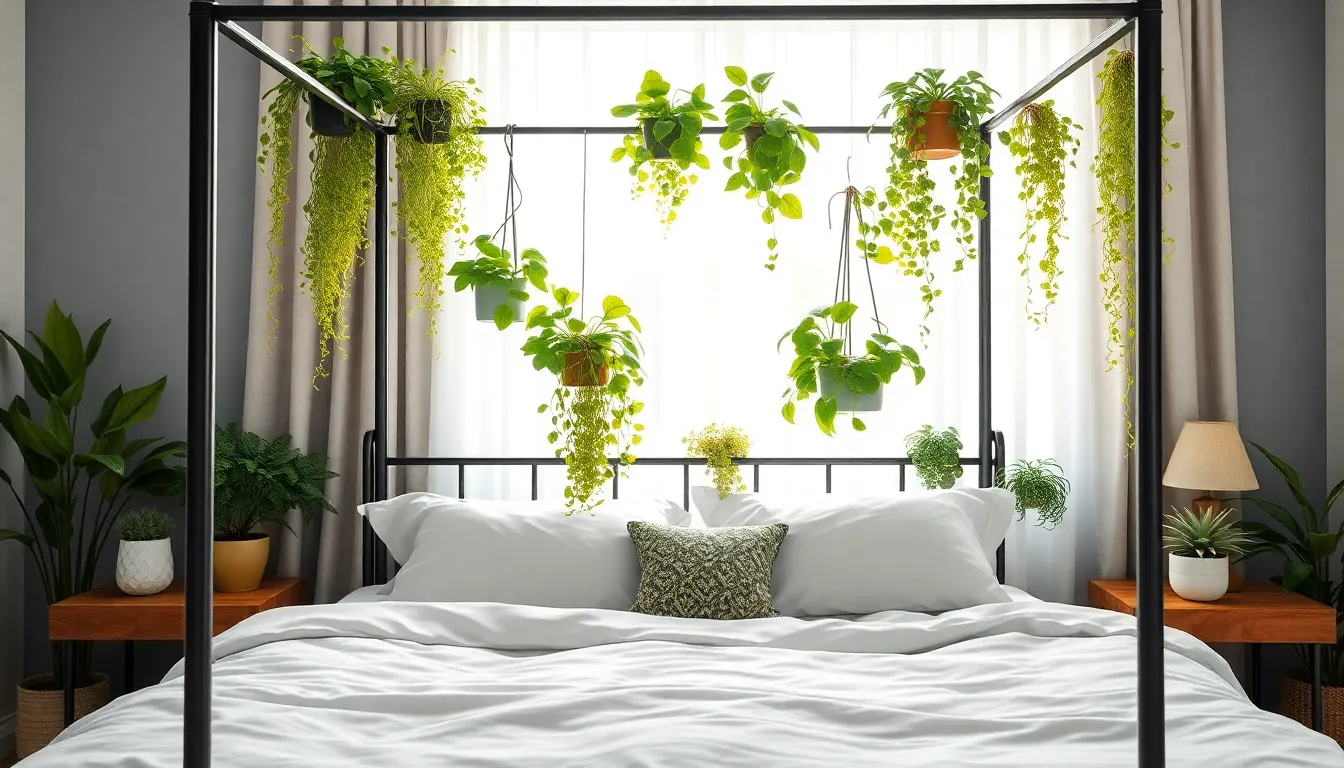
Selecting the right canopy bed frame creates the foundation for your botanical bedroom transformation. We need to consider both the structural support for hanging plants and how the frame complements our greenery.
Metal Canopy Frames for Modern Plant Displays
Metal canopy beds deliver sleek, industrial aesthetics that perfectly showcase contemporary plant arrangements. Their sturdy construction supports heavier plants like hanging succulents and trailing pothos without compromising stability. We love how the minimalist design creates a subtle backdrop that makes vibrant greenery pop against the clean lines.
Steel frames offer exceptional durability for mounting plant hangers directly onto the rails. The powder-coated finishes resist moisture from watering routines while maintaining their modern appeal. Contemporary bedrooms benefit from this style because the metal’s neutral tones complement both colorful foliage and monochromatic plant collections.
Wooden Canopy Structures for Natural Botanical Vibes
Wooden canopy beds bring organic warmth that naturally harmonizes with plant life in any botanical bedroom. The wood’s natural texture creates visual continuity with your green companions while supporting customization options like built-in shelves or mounted hooks. We find that oak, pine, and bamboo frames particularly enhance the connection between indoor plants and natural materials.
Farmhouse and rustic decor styles thrive with wooden canopy structures because they create cohesive botanical themes. The frame’s organic appearance blends seamlessly with trailing vines and cascading plants. Many wooden frames accommodate weight modifications for heavier planters while maintaining their structural integrity.
Four-Poster Beds That Support Hanging Gardens
Four-poster beds transform into living garden trellises that support elaborate hanging plant displays. Each vertical post provides mounting points for macramé holders, hanging planters, and climbing plant supports. We recommend using these classic frames for creating dramatic overhead canopies with plants like philodendrons, ivy, and trailing jade.
The posts create natural zones for different plant heights and growing patterns. Pothos and hoya varieties drape elegantly along the horizontal rails, creating cascading green waterfalls around your sleeping space. Over time, climbing plants establish natural privacy screens while maintaining easy access for maintenance and watering.
Select the Best Plants for Your Canopy Bed With Plants Setup
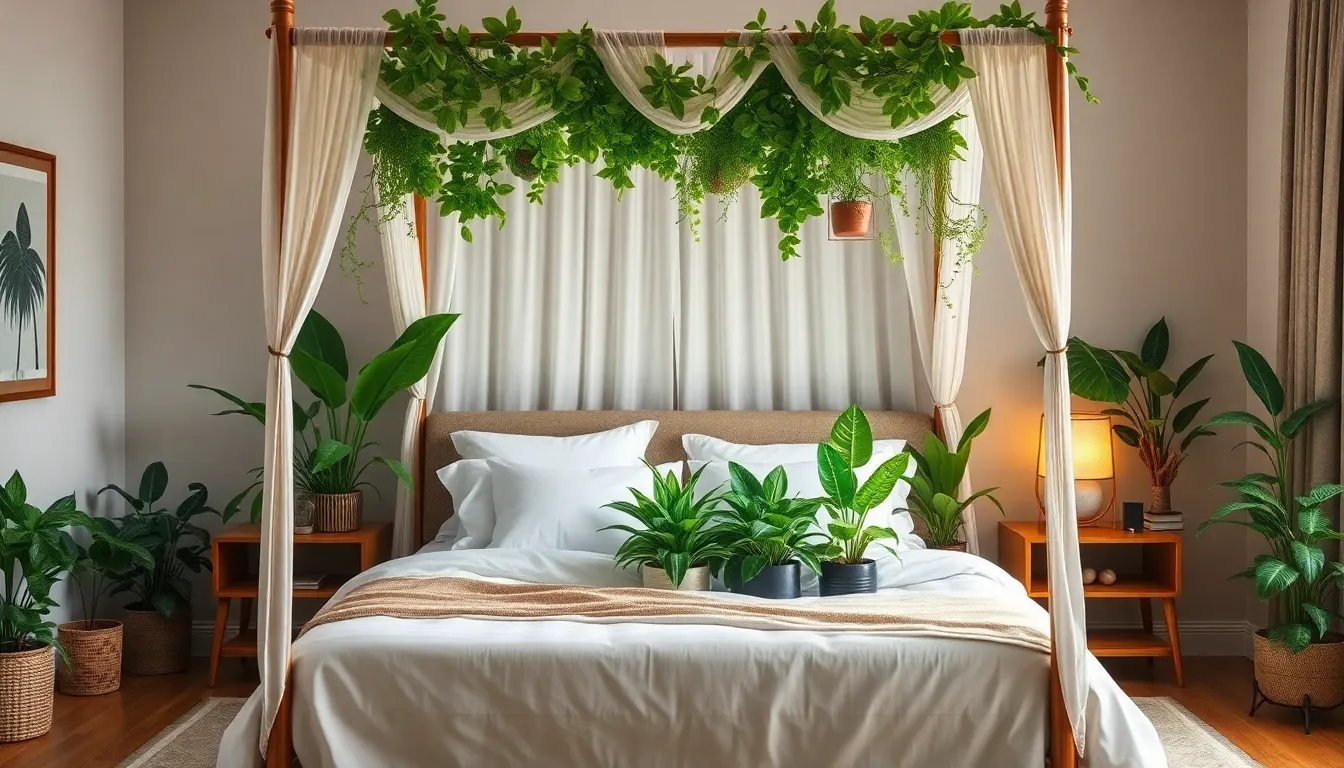
Now that you’ve secured your canopy frame, we’ll help you choose the ideal plants that’ll transform your bedroom into a botanical sanctuary. The key is selecting varieties that complement your canopy structure while thriving in bedroom conditions.
Low-Light Trailing Plants for Bedroom Environments
Chinese Evergreen (Aglaonema) leads our list of bedroom suitable plants because it thrives in low light conditions and offers colorful leaf variations that add visual interest to your canopy setup. This variety prefers moist soil and adapts well to the limited natural light typical in bedroom spaces.
Maidenhair Fern (Adiantum Raddianum) brings delicate trailing fronds that create an ethereal cascade from your canopy frame. While it prefers medium to bright indirect light, this adaptable fern adjusts to bedroom lighting conditions and adds graceful movement to your plant display.
Hoya Tricolor offers variegated leaves that trail beautifully from canopy structures, tolerating lower light while providing colorful contrast. We recommend this trailing variety for its ability to create stunning cascading effects that enhance your canopy’s vertical elements.
Philodendron Emerald Green features large bright green foliage with self-heading growth patterns that fill vertical space effectively. This variety tolerates low light conditions common in bedrooms while providing substantial visual impact near your canopy bed.
Air-Purifying Plants That Thrive Indoors
Snake Plant (Sansevieria Laurentii) converts CO2 into oxygen at night, making it exceptional for bedroom air quality improvement. Its upright, sword like leaves add structural contrast to trailing varieties while requiring minimal maintenance in your canopy setup.
Aloe Vera absorbs benzene and other indoor toxins while offering healing properties for minor cuts and burns. We value this succulent for its dual functionality as both an air purifier and natural remedy that thrives in bedroom conditions.
Peace Lily removes mold spores and volatile organic compounds (VOCs) from your bedroom air effectively. This flowering plant prefers indirect sunlight and adds elegant white blooms to complement your green canopy garden.
Boston Fern (Sword Fern) excels at removing indoor air pollutants while adding humidity to dry bedroom environments. Its feathery, drooping leaves make it perfect for hanging applications near your canopy bed.
Non-Toxic Plant Varieties for Safe Sleep Spaces
Orchids provide hypoallergenic blooms that add color without toxicity concerns, making them ideal for bedrooms shared with children or pets. These flowering plants thrive in the indirect light conditions typical of canopy bed setups.
Maidenhair Fern and Boston Fern rank among the safest options for bedroom environments, posing no toxicity risks if accidentally ingested. Both varieties offer beautiful foliage that enhances your canopy’s natural aesthetic.
Hoya Carnosa can be trained on trellises or allowed to cascade safely from your canopy frame, providing lush growth without safety concerns. This trailing plant creates wild, natural aesthetics that complement wooden and metal canopy structures equally well.
Design Your Plant Canopy Layout for Maximum Visual Impact
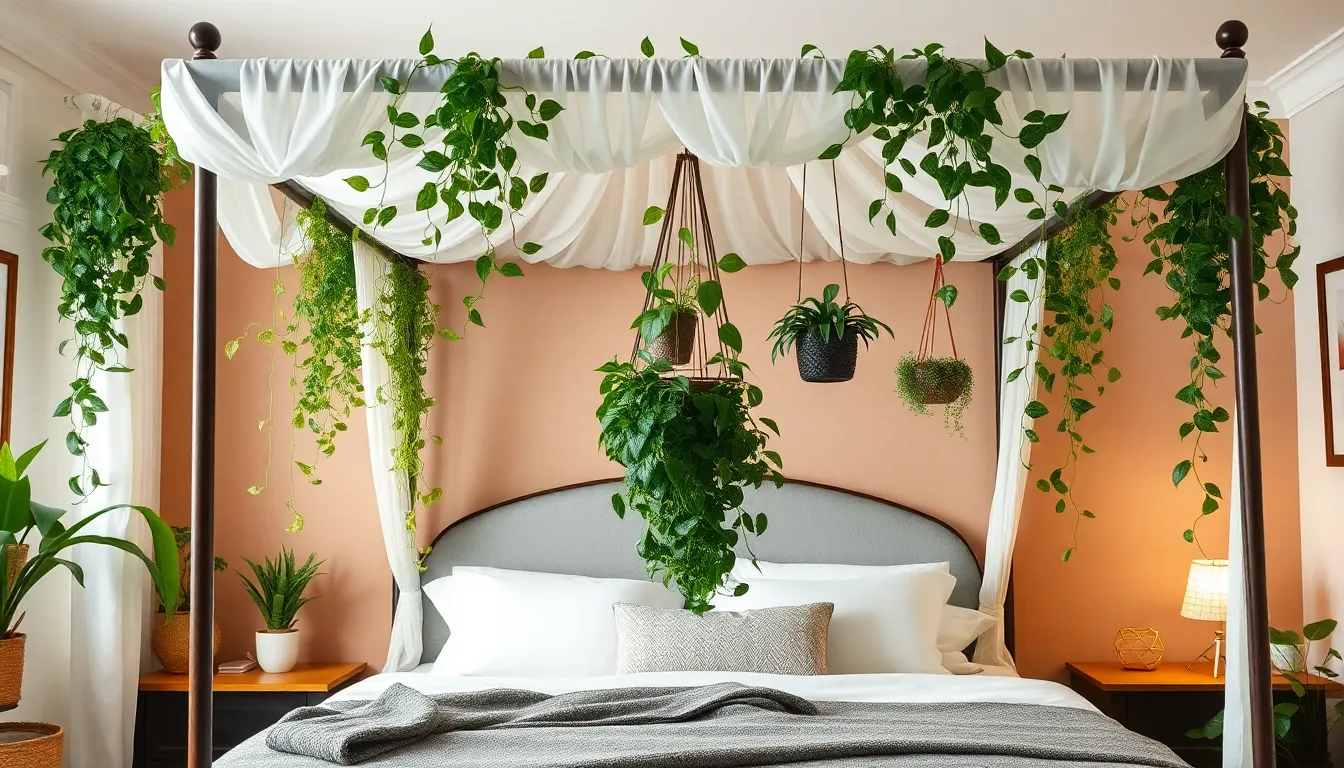
Creating a stunning plant canopy requires thoughtful planning that transforms your bedroom into a lush botanical sanctuary. We’ll guide you through strategic design principles that maximize visual drama while maintaining plant health.
Create Cascading Plant Arrangements
Select trailing varieties like Philodendron, Pothos, and Hoya to achieve elegant cascading effects that flow naturally down your canopy’s sides. These plants create stunning vertical waterfalls of greenery that draw the eye upward while softening harsh bed frame edges.
Position hanging baskets with built-in lips or saucers directly onto your canopy frame using sturdy mounting hardware. We recommend spacing these planters 18-24 inches apart to allow each plant adequate growing room while creating continuous coverage.
Layer different vine lengths by selecting plants at various growth stages, allowing some to trail 2-3 feet while keeping others shorter for dimensional depth. This approach creates a natural garden canopy that appears organically established rather than artificially arranged.
Balance Symmetry and Natural Growth Patterns
Establish symmetrical foundations by placing matching plant varieties on opposite sides of your bed to create visual balance that frames your sleeping space. Start with identical Pothos or Philodendron specimens positioned at equal distances from your headboard.
Allow organic development between your symmetrical anchor points, letting plants grow at their natural pace while occasionally pruning wayward vines. This technique maintains structural balance while embracing the unpredictable beauty of living décor.
Rotate plant positions monthly to ensure even growth patterns, as plants naturally lean toward light sources and can create lopsided arrangements over time. Regular rotation keeps your canopy looking intentionally designed rather than accidentally overgrown.
Layer Different Plant Heights and Textures
Combine varying elevations by mounting plants at different heights across your canopy structure, creating a tiered forest effect that adds visual complexity. Position taller specimens like Snake Plants near the headboard while placing shorter varieties toward the foot of the bed.
Mix textural contrasts by pairing broad-leafed plants like Peace Lilies with delicate ferns or spiky Hoya varieties for ever-changing visual interest. This combination creates depth and prevents your canopy from appearing monotonous or flat.
Incorporate ground level elements by adding small potted plants on nightstands or floor planters beneath your hanging garden to create seamless transitions between your canopy and bedroom floor. This layering technique unifies your plant design throughout the entire sleeping space.
Install Proper Support Systems for Your Canopy Bed Plant Display
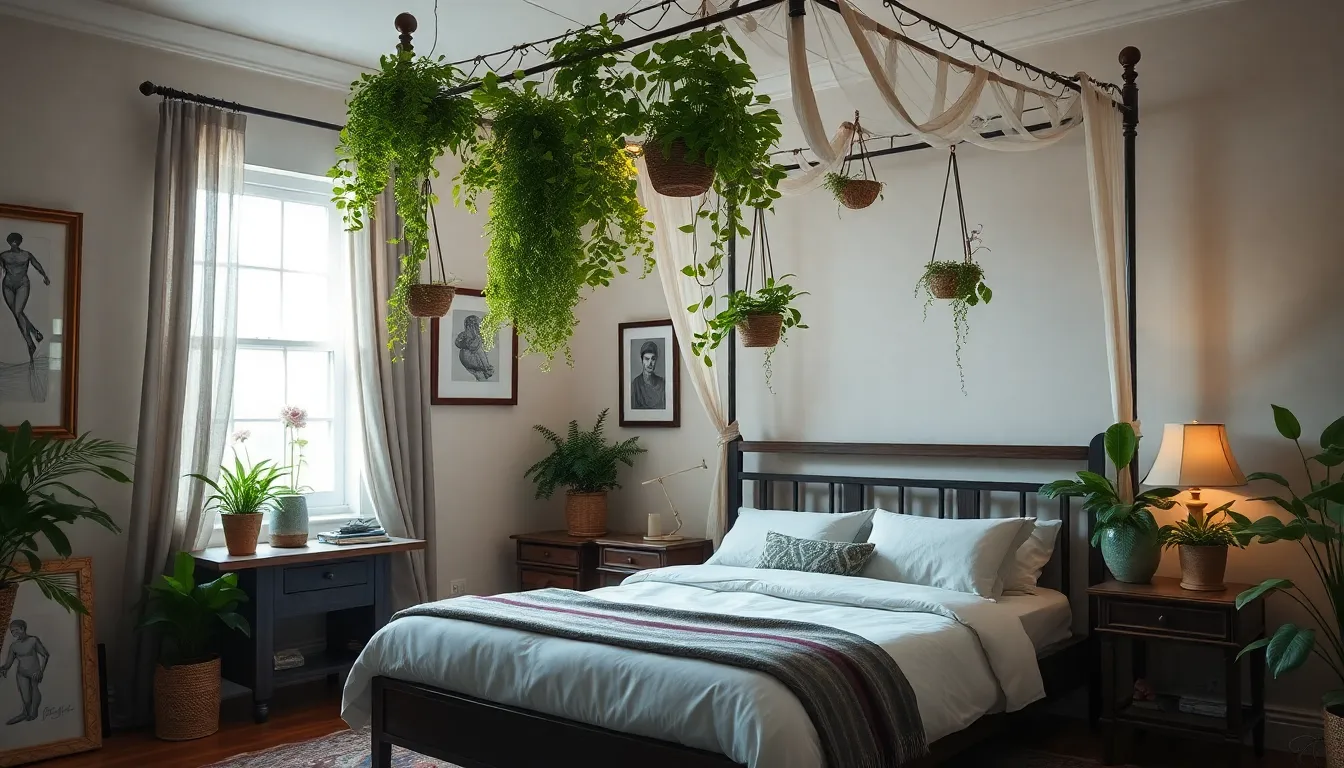
Building a successful canopy bed with plants requires establishing a foundation that can safely support our botanical display while maintaining the serene bedroom atmosphere we’ve created.
Secure Hanging Hardware for Heavy Plant Containers
Heavy-duty hanging hardware forms the backbone of our canopy bed plant installation, ensuring both safety and longevity of our botanical paradise. We’ll need ceiling hooks, lag screws, or reinforced curtain rod brackets specifically designed to handle the combined weight of containers, soil, and water. The type of ceiling material determines our hardware selection, whether we’re working with drywall, plaster, or concrete surfaces.
Professional consultation becomes essential when we’re uncertain about installation methods or ceiling load capacity. Reinforced brackets provide extra security for heavier plant arrangements, while lag screws offer superior holding power compared to standard screws. We should always choose hardware rated for at least twice the actual weight we plan to suspend.
Adjustable Plant Hooks and Brackets
Adjustable mounting systems give us the flexibility to customize our plant display heights and accommodate different growth patterns over time. These versatile hooks and brackets allow us to suspend containers at varying elevations, creating the layered visual effect we discussed in our design principles. We can easily reposition plants as they grow or change our arrangement seasonally.
Height adjustability ensures our plants receive optimal light distribution and proper airflow throughout the canopy structure. Swivel mechanisms on some adjustable brackets let us rotate plants for even growth exposure. Quick-release features make plant care and maintenance much more manageable without disturbing the entire display.
Weight Distribution Considerations for Safety
Weight calculations must account for the total load of all containers, growing medium, and water content before we begin installation. We’ll distribute this weight evenly across multiple support points rather than concentrating it in one area of our canopy structure. Uneven weight distribution can cause structural failure or damage to our bed frame.
Extra supports and crossbeams become necessary when our plant collection exceeds the original frame’s capacity. We should maintain adequate clearance between hanging plants and our sleeping surface to prevent accidents during nighttime movement. Regular weight assessments help us adjust our display as plants grow and containers become heavier with established root systems.
Maintain Your Canopy Bed With Plants for Long-Term Success
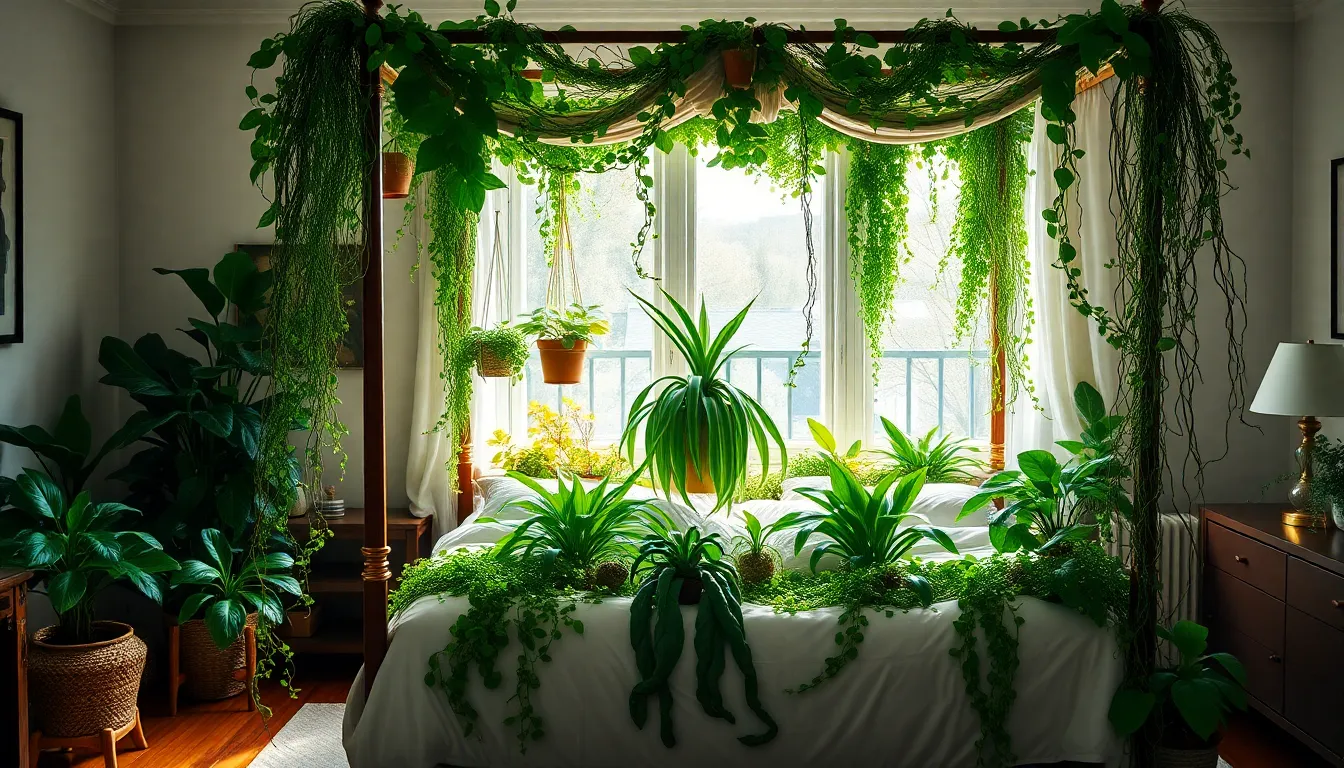
Sustaining your botanical canopy bed requires consistent care and attention to ensure both plant vitality and structural integrity. We’ll guide you through essential maintenance practices that keep your green sanctuary thriving year round.
Establish Proper Watering Routines
Watering schedules must align with each plant species’ exact needs to prevent root rot and maintain optimal health. Most indoor plants thrive when soil dries slightly between waterings, as overwatering remains the leading cause of plant failure in bedroom environments.
Check soil moisture by inserting your finger 1 to 2 inches deep into the potting mix. Water only when the soil feels dry at this depth, ensuring you’re not creating waterlogged conditions that harm root systems.
Water slowly until liquid drains from each pot’s drainage hole, then remove excess water immediately. Never allow pots to sit in standing water, as this creates the perfect environment for root rot and fungal diseases.
Maintain humidity levels through misting or pebble trays filled with water placed beneath hanging containers. These methods increase air moisture without creating soggy soil conditions that damage plant roots.
Monitor Plant Health and Growth Patterns
Regular observation helps us catch potential issues before they become serious problems affecting our canopy bed display. Look for early warning signs like fading flowers, wilting leaves, yellowing foliage, or unusual growth patterns that indicate stress or disease.
Remove faded blooms and dead leaves promptly to maintain good sanitation around your plants. This practice reduces disease risk and prevents pest infestations that can spread throughout your entire canopy system.
Rotate hanging plants occasionally to ensure even growth and prevent them from leaning toward light sources. Most bedroom plants require bright, indirect light rather than direct sunlight that can scorch delicate leaves.
Ensure adequate air circulation around all plant containers to prevent fungal problems. Poor ventilation creates conditions where mold and bacteria thrive, potentially damaging both plants and bedroom air quality.
Seasonal Care Adjustments for Indoor Plants
Winter care requires reducing watering frequency as plants enter slower growth periods with decreased light exposure. Plants need less water during cold months but still require consistent light sources to maintain health.
Avoid placing canopy plants near cold drafts from windows or heat sources like radiators during winter months. Temperature fluctuations stress plants and can cause leaf drop or stunted growth that affects your display’s appearance.
Repot plants every two years using quality indoor plant compost to refresh soil nutrients. Fresh potting mix provides essential nutrients and improves drainage for healthier root development.
Feed plants with liquid fertilizer biweekly during spring and summer growing seasons. Growing plants require additional nutrients to support new leaf development and maintain vibrant colors in your canopy display.
Protect plants from summer heat stress by adjusting their position within your canopy bed setup. Move containers to shadier spots or increase ventilation to prevent overheating that can damage sensitive plant varieties.
Style Your Canopy Bed With Plants to Match Your Decor

We can transform any canopy bed into a personalized botanical haven by matching plant arrangements to our existing decor style. Each design approach creates a unique atmosphere while maintaining the tranquil benefits of our plant-enhanced sleeping space.
Bohemian Plant Canopy Bed Aesthetics
Abundant hanging plants create the signature bohemian jungle vibe we’re seeking. Trailing vines like pothos, philodendron, and hoya work beautifully when suspended from macramé hangers throughout the canopy frame. We’ll want to mix various plant species to achieve that free-spirited, eclectic feel that defines boho style.
Draping techniques transform the structural frame into a living green canopy. Trailing plants naturally cascade around the bed posts, forming organic curtains of foliage. This dense arrangement promotes tranquility through rich textures and creates that coveted connection to nature.
Layering different hanging pot styles enhances the eclectic aesthetic. Ceramic vessels, woven baskets, and vintage containers at varying heights create visual interest. Multiple plant varieties at different levels establish the relaxed, vibrant atmosphere that makes bohemian bedrooms so inviting.
Minimalist Modern Plant Integration
Strategic plant placement emphasizes clean lines without creating clutter. We’ll choose one or two plant types with sleek containers positioned thoughtfully on the canopy frame or nearby surfaces. Snake plants and succulents add fresh greenery while maintaining the uncluttered modern aesthetic.
Subtle greenery complements rather than overwhelms the space. Simple arrangements focus on architectural plant forms that echo the bed’s geometric structure. We can achieve maximum impact with minimal elements by selecting plants that naturally enhance the room’s contemporary feel.
Sheer canopy fabrics paired with green accents create modern sophistication. Light materials allow plants to remain visible while softening the overall design. This combination delivers the crisp yet cozy environment that defines successful minimalist spaces.
Rustic Farmhouse Plant Canopy Designs
Natural wood frames provide the perfect foundation for earthy plant displays. Sturdy wooden canopy posts support trailing species like ferns and ivy arranged in textured baskets or weathered pots. This combination celebrates the farmhouse connection between indoor comfort and outdoor elements.
Cozy textiles mixed with living plants enhance the welcoming farmhouse charm. Wool throws and linen fabrics complement the organic textures of our chosen greenery. We’ll focus on plants that add natural texture while maintaining the warm, homey atmosphere.
Rugged materials balanced with soft foliage create the ideal farmhouse retreat. The contrast between weathered wood and delicate plant life establishes that signature farmhouse blend of strength and gentleness. This approach transforms our canopy bed into a personalized nature-inspired sanctuary that feels both grounded and nurturing.
Troubleshoot Common Challenges With Canopy Bed Plant Setups
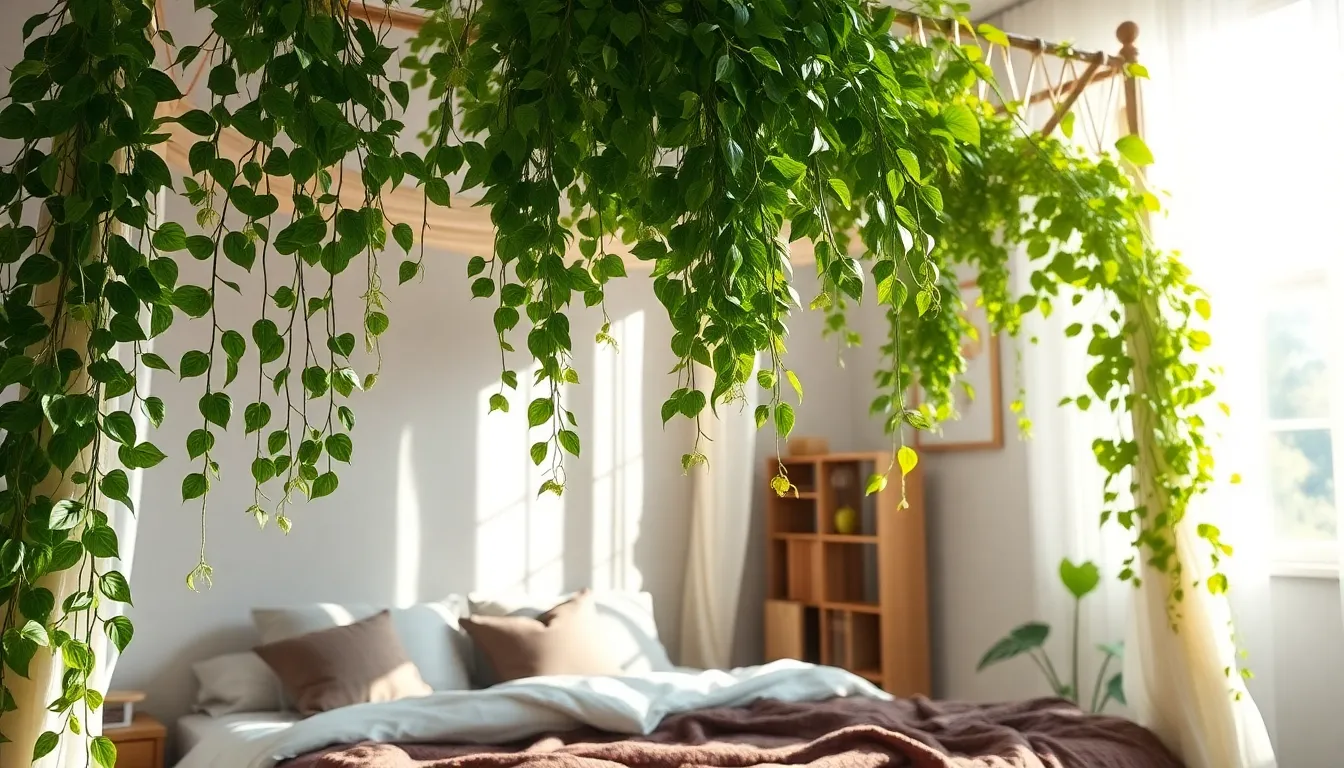
Even the most carefully planned canopy bed plant displays can encounter obstacles that threaten both plant health and bedroom furnishings. We’ll address the three most critical challenges that arise when incorporating greenery into your sleep sanctuary.
Prevent Water Damage to Bedding and Furniture
Drip trays and waterproof liners serve as your first line of defense against moisture damage to bedding and furniture. Position these protective barriers under every plant pot to catch excess water before it reaches expensive mattresses or wooden surfaces.
Self-watering pots and hydroponic systems eliminate the guesswork from watering routines while minimizing spillage risks. These automated answers maintain consistent moisture levels without creating the overwatering scenarios that lead to water damage.
Strategic plant placement prevents direct dripping onto fabric surfaces by positioning pots slightly above the bed canopy rail. Hanging plants should clear the mattress area by at least 12 inches to avoid accidental water contact during sleep movements.
Regular inspection and prompt drying of any water spills prevent mold and mildew buildup in bedroom environments. Check the area beneath your canopy plants weekly and address moisture issues immediately to maintain a healthy sleep space.
Manage Plant Pests in Bedroom Environments
Thorough plant inspection before bringing greenery indoors prevents introducing unwanted pests to your bedroom sanctuary. Examine leaves, soil surfaces, and pot drainage holes for signs of spider mites, aphids, or other common indoor plant pests.
Natural pest deterrents like neem oil and insecticidal soap provide effective control without introducing harsh chemicals near your sleeping area. Apply these treatments during daylight hours and ensure proper ventilation during application.
Adequate air circulation around plants reduces humidity levels that encourage pest development and reproduction. Position fans strategically to create gentle airflow without creating drafts that might disturb your sleep comfort.
Leaf cleaning and surrounding area maintenance eliminate pest habitats before infestations can establish. Wipe plant leaves monthly with a damp cloth and vacuum the floor beneath hanging plants to remove fallen debris.
Proper plant spacing prevents overcrowding that creates humid microclimates attractive to pests like spider mites and aphids. Allow at least 6 inches between hanging plants to promote air circulation and reduce pest-friendly conditions.
Address Light Requirements for Healthy Growth
Plant selection based on natural light availability ensures thriving greenery around your canopy bed setup. Trailing pothos, philodendrons, and hoyas adapt well to the moderate indoor light conditions typical in bedroom environments.
Supplemental grow lights provide necessary illumination when natural light proves insufficient for healthy plant growth. Position LED grow lights to distribute even coverage across your canopy plants without creating harsh shadows or bright spots that might interfere with sleep.
Training plants on supports such as trellises, nets, or stakes optimizes their light exposure while maintaining attractive arrangements. Guide climbing varieties upward and trailing plants downward to maximize each leaf’s access to available light sources.
Regular plant rotation ensures uniform growth by exposing all sides to adequate light over time. Quarter-turn your hanging plants weekly to prevent lopsided development and maintain the balanced aesthetic of your canopy bed display.
Conclusion
Creating a canopy bed with plants transforms your bedroom into a living sanctuary that nurtures both body and soul. We’ve shown you how this innovative design approach combines aesthetic beauty with practical wellness benefits that’ll enhance your daily life.
The key to success lies in thoughtful planning and consistent care. By following our guidance on plant selection support systems and maintenance routines you’ll create a thriving botanical display that stands the test of time.
Your plant-adorned canopy bed isn’t just furniture—it’s an investment in better sleep improved air quality and a more peaceful living environment. Start small experiment with different plants and watch as your bedroom evolves into the tranquil retreat you’ve always dreamed of.
Frequently Asked Questions
What are the main benefits of creating a canopy bed with plants?
A canopy bed with plants offers multiple benefits including enhanced aesthetics that transform your bedroom into a tranquil retreat, improved air quality through natural air purification, and better sleep quality in a more serene environment. This botanical setup creates a peaceful sanctuary while adding visual interest and natural beauty to your bedroom space.
Which plants work best for a canopy bed setup?
The best plants for canopy beds are low-light tolerant varieties such as snake plants, peace lilies, Chinese evergreen, and maidenhair ferns. Trailing plants like pothos, philodendron, and hoya create beautiful cascading effects. Choose air-purifying and non-toxic options to ensure both health benefits and safety in your bedroom environment.
What type of canopy bed frame is ideal for supporting plants?
Metal frames offer sturdy support for heavier plants with a sleek, industrial aesthetic perfect for contemporary designs. Wooden frames provide organic warmth and customization options that complement natural plant elements. Four-poster beds are excellent for creating elaborate hanging gardens, utilizing vertical posts for mounting various plant displays effectively.
How do I prevent water damage when watering plants above my bed?
Use drip trays and waterproof liners under all hanging plants to catch excess water. Consider self-watering pots to manage moisture levels automatically. Install plants with proper drainage systems and use plant saucers. Water plants carefully and allow excess water to drain completely before returning them to their hanging positions.
What support systems are needed for a plant canopy bed?
Install heavy-duty hanging hardware capable of supporting the combined weight of plants, soil, and water. Use adjustable plant hooks and brackets for customizable display heights. Ensure proper weight distribution across the canopy structure and consult professionals for installation when uncertain. Regularly assess support systems as plants grow and gain weight.
How do I maintain plants in a canopy bed setup?
Establish consistent watering routines tailored to each plant species’ needs. Monitor soil moisture regularly and ensure adequate air circulation. Rotate plants for even growth and light exposure. Make seasonal care adjustments, including proper winter care, regular repotting, and feeding during growing seasons to maintain healthy, vibrant plants year-round.
Can I create a plant canopy bed in a small bedroom?
Yes, plant canopy beds work well in small spaces. Choose compact trailing plants and utilize vertical space efficiently. Select lightweight plants that won’t overwhelm the room. Use minimal hanging baskets strategically placed to maximize impact without cluttering. Focus on air-purifying varieties to enhance the benefits in smaller spaces.
How do I deal with pests in bedroom plants?
Inspect all plants thoroughly before bringing them indoors. Use natural pest deterrents like neem oil or insecticidal soap. Ensure adequate air circulation to prevent pest-friendly humid conditions. Quarantine new plants initially and regularly check existing plants for signs of infestation. Remove affected plants immediately if pest problems persist.
What lighting considerations are important for canopy bed plants?
Most bedroom plants need low to moderate light conditions. Choose species adapted to indoor lighting or supplement with grow lights if necessary. Rotate plants regularly to ensure even light exposure. Position trailing plants where they can receive adequate light while creating the desired cascading effect over your bed.
How do I style a plant canopy bed to match my decor?
For bohemian style, use abundant hanging plants and diverse species for a jungle-like atmosphere. Minimalist designs focus on clean lines with strategic plant placement and fewer varieties. Rustic farmhouse styles emphasize natural wood frames with earthy plant displays. Match plant containers and hanging materials to your existing bedroom decor elements.

